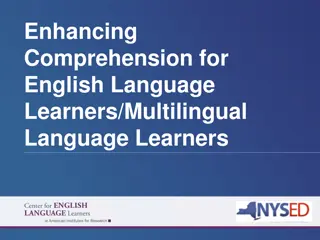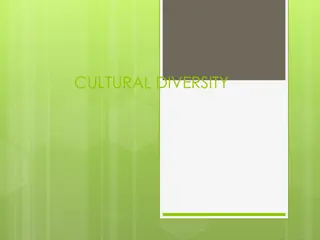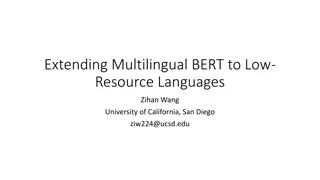Language in Multilingual Societies: Embracing Diversity
In multilingual societies, people navigate daily life using multiple languages for various purposes. From home to work to prayer, different languages play a crucial role in communication and social organization. The interaction of speakers of multiple languages in such environments can lead to language maintenance or shift. Embracing linguistic diversity and mastering multiple languages are essential for thriving in multilingual societies.
Download Presentation

Please find below an Image/Link to download the presentation.
The content on the website is provided AS IS for your information and personal use only. It may not be sold, licensed, or shared on other websites without obtaining consent from the author. Download presentation by click this link. If you encounter any issues during the download, it is possible that the publisher has removed the file from their server.
E N D
Presentation Transcript
Language in Multilingual Societies
In many parts of the world it is just a normal requirement of daily living that people speak several languages: perhaps one or more at home, another in the village, still another for purposes of trade, and yet another for contact with the outside world of wider social or political organization. These various languages are often acquired through simple exposure to the language, although one language or more in a speaker s repertoire may be learned through schooling or in an instructional setting.
Example I use Oriya in my home, English in my work place, Hindi for television viewing, Bengali to communicate with my domestic helper, a variety of Hindi-Punjabi-Urdu in market places in Delhi, Sanskrit for my prayer and religious activities, and some conversational Kui with the Konds for my research in their community. These languages fit in a mutually complementary and non-competing relationship in my life. (Mohanty 2006, 263)
Requirements for living in a multilingual society Master several languages Master the art of knowing the appropriate language for each social context
Question .? What happens when the speakers of multiple languages, come into contact? Scenario 1: Groups of people who speak different languages live near each other; sometimes there are political boundaries that divide them (e.g Germany & France)and sometimes they are identified as being part of the same nation (e.g German & French speaking regions of Switzerland), but in all such cases they have contact and must communicate.
Question .? What happens when the speakers of multiple languages, come into contact? Scenario 2: Movement of speakers of one language into an area where another language is spoken this is the case for immigration, colonialization, and various scenarios of conquest.
Answer: Scenarios 1 & 2 In scenario one, we have what is called language maintenance, that is, both languages continue to be spoken. In scenario two, there is likely to be one language which has social dominance, and in this situation language shift may occur, that is, speakers shift to speaking the dominant language.
Official status for languages in multilingual communities The negotiation of official status for languages in multilingual communities or nations involves a number of social, political and attitudinal factors. These factors all contribute to what we can call the ethnolinguistic vitality of the different linguistic varieties
Ethnolinguistic Vitality 1: refers to the demographic, social and institutional strength of a language and its speakers. In multilingual communities, different languages have more or less vitality in different (institutional, social or personal) domains. Social, political and attitudinal factors contribute to the ethnolinguistic vitality of the different linguistic varieties.
Ethnolinguistic Vitality 2: The term ethnolinguistic vitality takes its name from two issues. A linguistic variety has relatively high vitality if it is spoken and used widely. This kind of vitality is a good indicator of whether or not that particular language will continue to be spoken in successive generations, or whether speakers are likely to shift to another language. The word ethnolinguistic reflects the belief that the use of a particular language variety is an extremely significant factor in defining a cultural or ethnic identity.
Ethnolinguistic Vitality 3: In situations of immigration, commonly within three generations, members of the minority group shift to the dominant language. In some scenarios, we have what is called language maintenance, that is, both languages continue to be spoken. How likely a threatened language is to be maintained?
Ethnolinguistic Vitality 4: we must consider three things about any threatened language: (1) its status: economic, social, and historical; (2) its territorial distribution and concentration together with its population demographics, for example, absolute numbers, birth rates, marriage patterns, and migrations in and out; and (3) its institutional support or lack thereof, both formally, as in the media, education, and government services, and less formally, as in the workplace and in religious, social, and cultural activities.
Status factors influencing language vitality If the speakers of a language have relatively high social status within the larger community perhaps because they have higher social or economic status the ethnolinguistic vitality of that variety will be higher too. The status of the language within the community and outside the community also matters. So too does the historical status that variety has had in the community.
Institutional factors influencing language vitality Institutional support also contributes to increased vitality of a language and therefore promotes its maintenance and use. Widespread use of a language in the popular mass media, as the medium of education, and in official government business all increase its relative vitality.
Demographic factors influencing vitality If the group of people speaking the language outnumber the speakers of other languages, and particularly if they are relatively concentrated in a specific area, then the long-term prognosis for the maintenance of that language is improved.
DIGLOSSIA IN A COMMUNITY:1 Diglossia is the term used to describe a situation in which there are two distinct codes with clear functional separation; that is, one code is employed in one set of circumstances and the other in an entirely different set.
DIGLOSSIA IN A COMMUNITY 2 In Charles Ferguson s words diglossia is a relatively stable language situation in which, in addition to the primary dialects of the language (which may include a standard or regional standards), there is a very divergent, highly codified (often grammatically more complex) superposed variety, the vehicle of a large and respected body of written literature, either of an earlier period or in another speech community, which is learned largely by formal education and is used for most written and formal spoken purposes but is not used by any sector of the community for ordinary conversation.
DIGLOSSIA IN A COMMUNITY 3 Ferguson called the language with higher overt prestige, and which is used in more formal contexts and for writing (e.g., church, newspapers), the High variety (H) , and the vernacular variety (for Low (L) functions (e.g., in the home, or market) the Low variety (L). The major characteristics of the diglossic phenomenon are clearly seen in the situation of Arabic speaking countries, in which the two varieties are Modern Standard Arabic (H) and the various regional colloquial varieties (L)
CODE SWITCHING People who speak more than one language, or who have command over more than one variety of any language, are generally very sensitive to the differences in the vitality of the languages they use and they are equally aware that in some contexts one variety will serve their needs better than another. This may lead them to change the variety they use depending on where they are. This phenomenon of moving between distinct varieties is known as code switching.
CODE SWITCHING When code switching is constrained by where speakers happen to be, it can be called domain-based or situational code switching. Situational code-switching occurs when the languages used change according to the situations in which the speakers find themselves: they speak one language in one situation and another in a different one. When it is constrained by who a speaker happens to be talking to it can be called addressee-based. In addition, there are other more metaphorical motivations for code switching
METAPHORICAL CODE SWITCHING Metaphorical code-switching has an affective dimension to it: the choice of code carries symbolic meaning, that is, the language fits the message. This is illustrated in a quote attributed to Charles V, the Holy Roman Emperor, which indicates attitudes about certain languages being holy, the language of love or male solidarity, or crude or bestial: I speak Spanish to God, Italian to women, French to men, and German to my horse.
CODE MIXING Code mixing generally refers to alternations between varieties, or codes, within a clause or phrase. Often elicits more strongly negative evaluations than alternations or code switching across clauses. The switching here happens within and between turns.



























